Microsoft BUILD: Windows 8, A Pre-Beta Preview
by Brian Klug & Ryan Smith on September 13, 2011 12:05 PM EST- Posted in
- BUILD
- Windows
- Microsoft
- Windows 8
- Trade Shows
Mobile Experience Side
Coming from the smartphone side of things, I really see many shades of WP7 inside Windows 8. That’s actually dramatically understating the state of things - the core of what we’ve been shown of Windows 8 that’s new literally is either adopted from or directly analogous to much of WP7.
It doesn’t come as a surprise to me at all that the desktop Windows experience is moving in this direction, (and it seems as though the Xbox 360 interface will follow shortly). The positive result is that Windows 8’s touch experience feels much closer to the ground-up approach Android Honeycomb or iOS have taken than the than the “Tablet-Edition” versions of Windows XP and the tablet integration in Vista and 7. I used a UMPC and remember Origami and how that application lived as its own standalone mode of operation as an application within windows. What Windows 8 is the inverse - Windows now lives inside a Metro-themed Start screen that looks like WP7 for the desktop. Or at least it does in this demo we’ve been shown currently.
The tablet experience is now absolutely on par with modern mobile OSes - sure there are a few more things that need to be included, but the foundation is there for Windows to suddenly become more than an OS that also can do touch-based interaction.
IE 10
Microsoft has been actively promoting IE 10 since MIX 11, with two platform previews so far, and IE 10 is an integral part of Windows 8 both as a browser and as a runtime for HTML based Metro applications. We won’t go into exacting detail about what’s new and interesting inside IE10, beyond mentioning that it improves upon IE 9’s GPU acceleration and improves web compliance support including CSS3. What’s relevant in Windows 8 is that IE 10 gets two views - one belonging to the Metro-heavy start menu experience, which we’ll call the mobile view, and the other belonging to the traditional desktop windows view.
This dichotomy exists between the two IE10 experiences, which is in itself a bit curious. The mobile view is almost exactly what IE looks like inside Windows Phone 7.5 - at the bottom is the URL bar and controls, and with a slide down gesture, at the top are tabs. Meanwhile the IE10 desktop experience uses the older IE 9 UI. At this point, it doesn’t appear that windows opened in one are transportable to the other.
The mobile view is almost exactly like WP7.5’s however, the URL bar disappears when scrolling, and the browser supports a completely fluid multitouch experience that feels speedy.
Cloud
Windows 8 offers considerable integration with Windows Live and SkyDrive. Local user accounts can be directly tied to a Live account on trusted PCs, and then be used for live roaming. Live roaming enables each connected device to access the same set of accounts for photos, email, calendar, and contacts and speed up initial setup. For example, photos captured on a WP7.5 device’s camera roll can be immediately visible on a Windows 8 PC authenticated against the same Live account. This is very close to how camera roll will integrate into Apple’s iCloud and synchronize across iOS and OS X Lion.
One thing is clear, and it’s that Microsoft plans to heavily integrate and leverage its Live services into Windows 8 and provide an ecosystem-wide way to migrate accounts settings, photos, and data between mobile, tablet, and desktop.
Samsung’s Reference Tablet
We’ve been loaned Samsung tablets running the Windows 8 Evaluation copy used for this article, and thought it bears going over since the device will no doubt become a reference platform for Windows 8 development. This hardware is also being given away to developers in attendance at BUILD as well.
The Samsung tablet is none other than the 700T model announced at IFA very recently, and it packs a relatively impressive spec list.
| Samsung 700T Windows 8 Development Notebook/Slate - Specifications | |
| Processor |
Intel Core i5-2467M (2x1.6GHz + HT, 32nm, 3MB L3, 2.3GHz Turbo, 17W) |
| Chipset | Intel 6 series |
| Memory | 4 GB DDR3 1333MHz RAM (1 SODIMM) |
| Graphics | Intel HD 3000 |
| Display | 11.6" Super PLS (1366x768) |
| Hard Drive | 64 GB Samsung SSD |
| Networking | 802.11n WiFi + Gigabit Ethernet + GSM/WCDMA HSPA+ |
| Sensors | NFC, Magenetometer, Accelerometer, GPS, ALS, Front, Rear Camera |
| Dimensions | 12.9 mm thick, 909 grams |
The 700T includes GSM/WCDMA cellular connectivity courtesy of an Option GTM661W combination cellular modem and WiFi card. The GTM661W uses a Qualcomm MDM6200 baseband, which also provides GPS. There are also sensors such as ambient light, an accelerometer, and the two cameras onboard.
In addition, the 700T includes an active digitizer and capacitive touch display, making it suited for all three interaction modes that Windows 8 will support. The device comes with a dock that doubles as a charging stand, and also replicates full size HDMI, GigE, and a USB 2.0 port on the back. The slate has one USB 2.0 port, a headphone jack, microSD card slot, SIM slot, and a rotation lock button.
Samsung calls the 700T a slate, we've elected to call it a tablet, and the device feels decent if not a bit heavy in the hands. The 700T is also the first 16:9 tablet we've seen, with Android adopting 16:10 and iOS going with 4:3, which makes portrait a bit extreme.


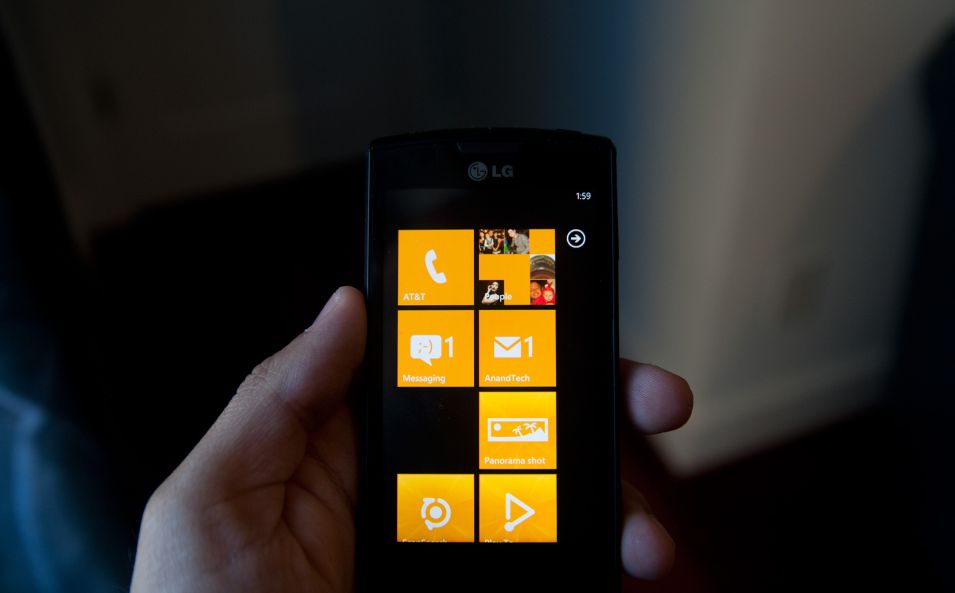
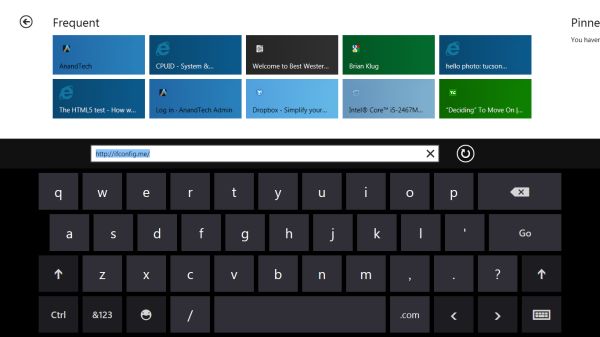
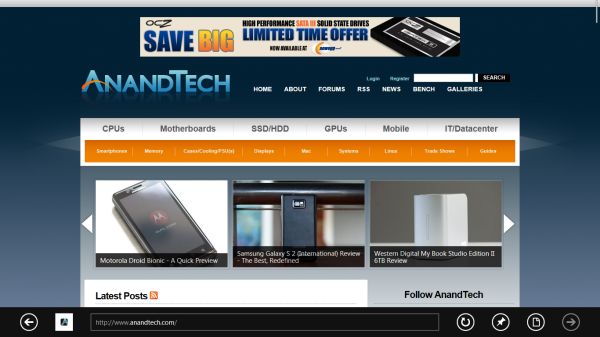
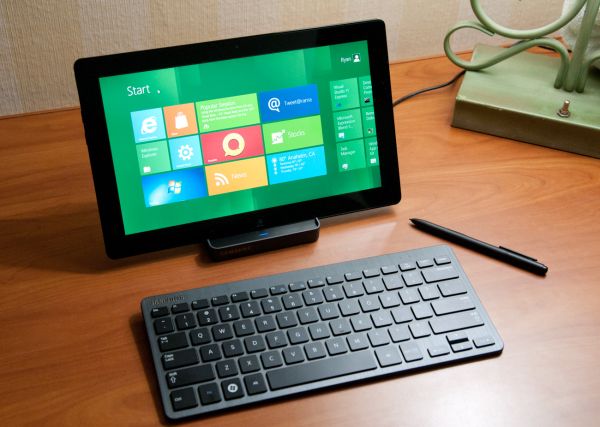
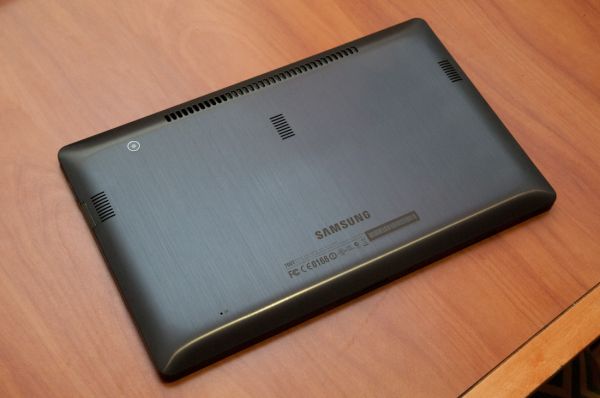
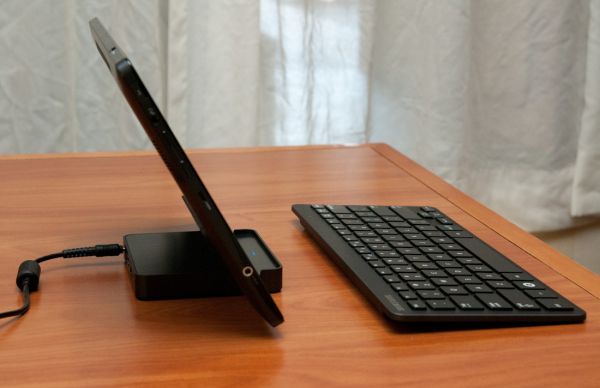








235 Comments
View All Comments
Saad_Salman - Tuesday, September 13, 2011 - link
I'm amazed how much MS is bragging about the so called 'windows tablet interface' with html5 (css & js) apps like it's never been done before. Dashboard? Remember something? Apple did it with Webkit application framework, with which, developers have been creating apps since OSX Tiger. Tiles are almost identical to dashboard with different ui.http://en.wikipedia.org/wiki/Dashboard_(software)
Bees - Tuesday, September 13, 2011 - link
How do we think it is going to handle multiple monitors? Will only one get the Metro treatment while the rest show the traditional desktop?tayb - Tuesday, September 13, 2011 - link
Metro is for portable devices. Slates, Tablets, etc. This will not be on your gaming rig.The freaking demo was done on a 11.1" tablet for crying out loud.
Not only that but if you don't like Metro no one, NO ONE, will force you to use it. And who in their right mind would use it on their desktop??? Haven't you seen the other screen shots of Windows 8? It's still a desktop OS. Metro is essentially an "add on" for mobile.
Rand - Tuesday, September 13, 2011 - link
It's helpful to read the article, and to read the tons of stuff MS has put up and all the live blogs from BUILD.You HAVE to use Metro, you have no choice. Microsoft WILL force you to use it, it is Windows. On all platforms you have Metro and you will be using it.
Metro is not as addon, it is the core of Windows.
Any time you launch an application or configure system settings, or bootup or anything of the like you will be using Metro. It cannot be disabled. There are no alternatives.
This will be on your gaming system, and your servers, and everything else. MS has made this abundantly clear. It's been stated in a dozen articles.
You cannot disable Metro.
rs2 - Tuesday, September 13, 2011 - link
"Microsoft WILL force you to use it, it is Windows."You seem to have confused Microsoft with Apple, and Windows with OSX. If anything, Microsoft has a fairly good track record of allow users to enable "Classic" features if they prefer them.
Rand - Tuesday, September 13, 2011 - link
No confusion, I just read what MS has said. Unless their lying, you cannot enable a classic experience.fausto412 - Tuesday, September 13, 2011 - link
is it really time for a new windows?Microsoft has lost its mind.
Malih - Tuesday, September 13, 2011 - link
But I know I'll be buying a Windows 8 tablet PC,or maybe if they can implement something like Kinect so you can operate the touch UI with non-touchscreen monitor, and do it from reasonable distance with good accuracy.
trip1ex - Tuesday, September 13, 2011 - link
MS is just creating the same tablets as they did before but with a tablet gui. And I think that is a mistake just as it was before.The end result is a big tablet with terrible battery life and heat issues at a high price. No one wants that as a tablet.
And no one wants the tablet form factor to use traditional desktop apps because then you might as well stick with the laptop.
And Win8 on ARM? Not seeing how they can pull that off and have decent battery life and performance still. I will believe it when I see it.
The beauty of the tablets i have used is the lightweight. The long battery life. The snappy performance for reading, email, video, and light weight tasks. The fact it gets out of the way. It is not just the form factor.
Win8 on ARM will be a mirage because Win8 will not truly work well on ARM
UMADBRO - Tuesday, September 13, 2011 - link
Once again, because you seem to have super powers and already know something about an unfinished product on unfinished hardware, you seem to be able to peer into the future and know everything there is to know about this. Bravo. Thank you for telling the masses your wonderful insight, instead of keeping it to yourself!